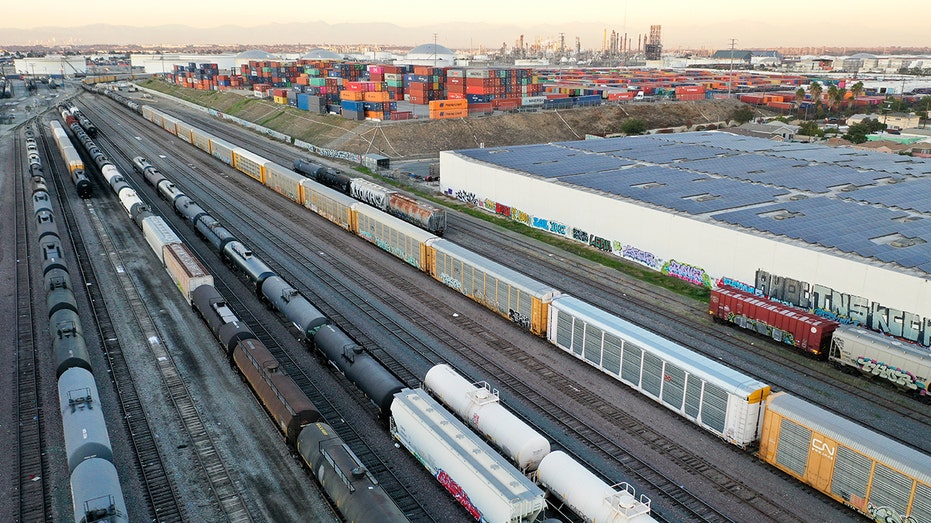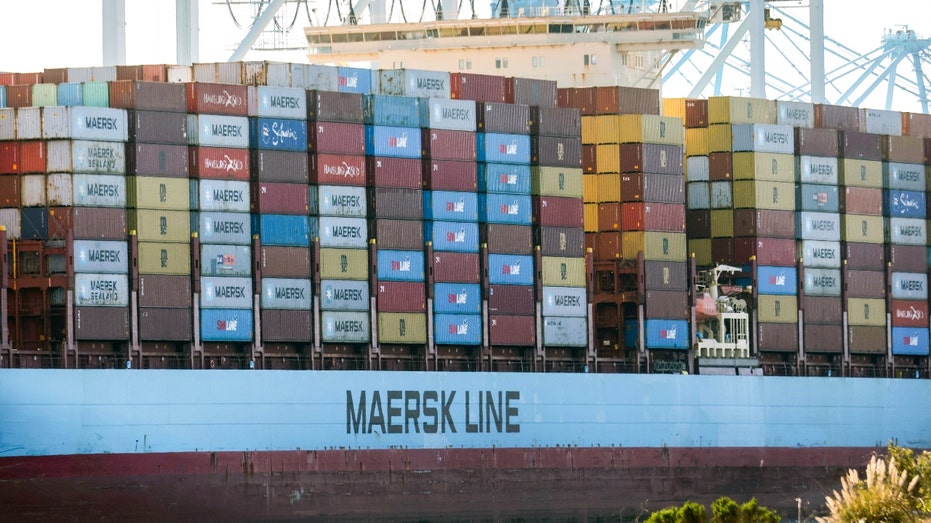The COVID-19 pandemic might not be gone, but the global supply-chain crisis it spawned has abated.
Goods are moving around the world again and reaching companies and consumers, despite some production snarls and Covid outbreaks inside China. Gone are the weekslong backlogs of cargo ships at large ports. Ocean shipping rates have plunged below prepandemic levels.
"It’s obvious that freight rates peaked and began to normalize, driven by falling demand and an easing supply-chain congestion," said Soren Skou, chief executive of Maersk. In November, the shipping company lowered its 2023 forecast for container demand—a proxy for global trade. It now expects a decline from 2% to 4%, from a maximum decline of 1% previously.

WILMINGTON, CALIFORNIA - NOVEMBER 22: In an aerial view, freight rail cars sit in a rail yard near shipping containers on November 22, 2022 in Wilmington, California. (Photo by Mario Tama/Getty Images / Getty Images)
In the U.S., retailers have ample inventory. Railroads averted a labor strike and package delivery trucks have plenty of spare capacity. That bodes well for U.S. consumers heading into 2023, executives and analysts say, although profits for transport companies will be pinched now that demand and supply are back in balance.
"Just to remind us of where we were, a year ago, in the holiday season, Americans were wondering if we would get basic goods, not to mention Christmas presents, when we needed them," said U.S. Transportation Secretary Pete Buttigieg in a speech at UPS Worldport in Louisville, Ky., in early December.
| Ticker | Security | Last | Change | Change % |
|---|---|---|---|---|
| AMKBY | A.P. MØLLER-MÆRSK A/S | 11.36 | +0.36 | +3.27% |
| UPS | UNITED PARCEL SERVICE INC. | 177.01 | +1.40 | +0.80% |
Parcel carrier FedEx Corp. and other regional carriers are having an easier time delivering packages this peak season, with additional capacity and steady parcel volume. On Tuesday, FedEx reported average daily parcel volumes fell 10.2%, declining for the fourth straight quarter.
| Ticker | Security | Last | Change | Change % |
|---|---|---|---|---|
| FDX | FEDEX CORP. | 175.93 | +0.24 | +0.14% |
There were generally enough package sorters, drivers and sorting machines, helping FedEx hit a higher on-time performance rate, 95.3%, in the last week of November, up from 83.9% in the same time a year ago, according to data from ShipMatrix Inc., a parcel analytics firm.
The U.S. Postal Service, which makes last-mile deliveries for several package delivery companies, said its previous investments in new sorting machines have helped expand its daily package processing capacity to 60 million a day. This has helped it better handle the holiday mailing and shipping rush.
There aren’t as many problems this year, said Satish Jindel, president of ShipMatrix. He estimates there is a surplus of capacity—enough to handle another three million to five million daily packages—for the peak season between Thanksgiving and the end of the year. In 2020 and 2021, there were deficits of daily capacity, equal to 4.7 million and 1.3 million packages, respectively.

MECHANICSVILLE, DANVILLE, PENNSYLVANIA, UNITED STATES - 2022/07/20: A United States Postal Service (USPS) worker exits a Grumman Long Life Vehicle. On July 20, the USPS announced that at least 40 percent of its Next Generation Delivery Vehicles (NGDV (Paul Weaver/SOPA Images/LightRocket via Getty Images / Getty Images)
Even before the holiday season, parcel carriers noted consumers had pulled back on buying goods online. People resumed spending on travel, parties and entertainment as the pandemic waned. Ample retail inventories have also compelled some companies to pull back on orders or restocking.
For some of the biggest U.S. manufacturers and retailers, supply-chain costs have become a budgetary bright spot rather than a liability. Procter & Gamble Co., for instance, expects to spend $100 million less than it had anticipated on transportation and warehousing in the fiscal year ending in June 2023, the company said in October.
| Ticker | Security | Last | Change | Change % |
|---|---|---|---|---|
| PG | PROCTER & GAMBLE CO. | 152.59 | +0.31 | +0.20% |
After more than a year of paying ever-higher prices for goods, Walmart Inc. and other large retailers are canceling manufacturer orders, resisting price increases and in some cases asking suppliers to provide discounts. Now, fully stocked, or in some cases stuck with excess inventory, retailers have more leverage in price negotiations with manufacturers.
| Ticker | Security | Last | Change | Change % |
|---|---|---|---|---|
| WMT | WALMART INC. | 143.77 | +0.29 | +0.20% |
"As some of commodity prices and transportation costs begin to come down, we’re revisiting these costs with our suppliers," said Bill Boltz, executive vice president of merchandising for home-improvement retailer Lowe’s Cos. "We anticipate that some of these clawbacks will be reinvested back into the portfolio through lower retail prices."
| Ticker | Security | Last | Change | Change % |
|---|---|---|---|---|
| LOW | LOWE'S COS. INC. | 201.88 | +2.73 | +1.37% |
Dollar General Corp., after years of citing high transportation costs as a drag on the business, said in December that falling transit prices could begin lifting the company in 2023.
| Ticker | Security | Last | Change | Change % |
|---|---|---|---|---|
| DG | DOLLAR GENERAL CORP. | 247.55 | +2.02 | +0.82% |
| AAPL | APPLE INC. | 131.86 | -0.37 | -0.28% |
Not all supply chains are running smoothly. Apple Inc. has warned that shipments of its high-end iPhone models would be hindered amid Covid restrictions at one of its major suppliers in China. Ford Motor Co. has raised the price of its electric F-150 Lightning pickup truck three times this year, partly because of supply-chain constraints and higher material costs. New waves of the pandemic or geopolitical tensions could create new problems.
| Ticker | Security | Last | Change | Change % |
|---|---|---|---|---|
| F | FORD MOTOR CO. | 11.37 | +0.07 | +0.57% |
Another potential snarl was averted recently when the White House interceded to end long-running contract talks between U.S. freight railroads and union groups. The decision imposed a five-year contract on both sides, preventing a potential December strike.
The major railroads, Union Pacific Corp., CSX Corp., BNSF Railway and Norfolk Southern Corp., said they have managed to hire more train and engine crew members in the second half of the year, following months of difficulties in recruitment. Some railroads said they reopened some hump yards and took out locomotives from storage to help ease some bottlenecks.
| Ticker | Security | Last | Change | Change % |
|---|---|---|---|---|
| UNP | UNION PACIFIC CORP. | 209.91 | +1.25 | +0.60% |
| CSX | CSX CORP. | 31.25 | +0.28 | +0.90% |
| NSC | NORFOLK SOUTHERN CORP. | 247.42 | +1.97 | +0.80% |
Powered By | ||||
"We have turned the corner on service," Norfolk Southern CEO Alan Shaw said during the company’s investor day in early December.
These changes helped to improve rail service from a low in the springtime this year, when dwell time and train speeds were at their worst levels. Customers said they have noticed improvements, but added that more can be done.
Railroad executives said they still need to balance volatility in demand. Lumber shipments are now much lighter compared with 2020 and 2021, when interest rates were lower and housing construction boomed. The railroads say they intend to draw more cargo currently on trucks back to rail, as rail service improves.
Goods are moving through the biggest U.S. port complex faster than at any time since cargo backed up at the swamped Los Angeles-Long Beach docks early in the pandemic. The average container’s dwell time is just 2.8 days, according to the Pacific Merchant Shipping Association. Meanwhile, U.S. container imports reached their lowest level in November since the early months of 2020, according to research group Descartes Datamyne.

Shipping containers sit aboard a Maersk container ship at the Port of Los Angeles on February 9, 2022 in San Pedro, California. (Photo by Mario Tama/Getty Images) (Mario Tama/Getty Images / Getty Images)
Higher interest rates, coupled with lower demand, are expected to further reduce the flow of goods. The World Trade Organization expects global goods trade to increase 1% next year from 2022, a slowdown from the estimated 3.5% expansion this year.
The slowdown is already evident in ocean-shipping rates. The daily spot rate to move a shipping container from Asia to the U.S. West coast is hovering around $1,400, down from about $7,500 in July and roughly $15,000 a year ago, according to the Freightos Baltic Index. The average cost in 2019, before Covid, was around $1,500.
"We clearly have to find a new balance in this new market" based on ocean freight rates, said Maersk head of ocean shipping Vincent Clerc, who will take over as CEO on Jan. 1.
Maersk is seen as a bellwether of global trade, with more than 700 ships in operation. The company said it is moving 30% fewer containers across the Pacific since last year, with dozens of vessels taken out of the trade.
"You can’t deploy more capacity than what our customers need," Mr. Clerc said. "We are going through a significant inventory correction in the U.S. and Europe, and we made significant capacity adjustments to our capacity in and out of Asia."
https://www.foxbusiness.com/economy/supply-chains-upended-covid-back-normal
No comments:
Post a Comment